John de Winchester
John de Winchester (died 1460) was a 15th-century English cleric who distinguished himself as an administrator and bishop in Scotland. Winchester was a student of canon law from 1418, graduating with a bachelorate in 1421.[1]
John de Winchester | |
|---|---|
| Bishop of Moray | |
 | |
| Church | Roman Catholic Church |
| See | Diocese of Moray |
| In office | 1435–1460 |
| Predecessor | Columba de Dunbar |
| Successor | James Stewart |
| Orders | |
| Consecration | 9 May 1347, at Cambuskenneth Abbey |
| Personal details | |
| Born | Unknown |
| Died | 1 April 1460 Probably Spynie Castle |
| Previous post(s) | Chancellor of Dunkeld |
He appears to have entered Scotland in 1424 after King James I of Scotland returned from his eighteen-year period as a hostage in England; it is notable and certainly relevant that James' queen, Joan Beaufort, was the niece of Henry Beaufort, Bishop of Winchester.[2]
After entering Scotland, James was chaplain and secretary to the king, who bestowed on Winchester Alyth in Angus and helped him become Chancellor of Dunkeld.[3] Winchester was out of Scotland in 1432, attending the Council of Basel on behalf of King James; he was also Clerk of the Register in this year.[2]
He was Dean of Aberdeen in 1431,[4] and was provided as Treasurer of the diocese of Glasgow sometime in 1431, but was not able to take up this position.[5] However, he did become Provost of the Collegiate Church of Lincluden between 1434 and 1436.[6]
Winchester's services to the king were rewarded further in November 1435 when, after the death of Columba de Dunbar, he was elected as Bishop of Moray.[7] He was not, however, consecrated until 9 May 1437, a few months after the death of King James; his consecration took place at Cambuskenneth Abbey.[8]
After becoming bishop, Winchester continued in the service of Queen Joan through the minority of James II of Scotland. James II later rewarded Winchester by creating Spynie as a burgh of Barony on 24 July 1451; after James II murdered the ex-regent William Douglas, 8th Earl of Douglas in 1452, Spynie's status was raised to that of burgh of regality.[9]
Bishop Winchester died April, 1460, probably at Spynie Castle[10] and was buried in St Mary's Aisle within Elgin Cathedral.[11]
Notes
- McGladdery, "Winchester, John (died 1460)"; Dowden says civil law (decrees), Dowden, Bishops of Scotland, p. 159.
- McGladdery, "Winchester, John (d. 1460)".
- McGladdery, "Winchester, John (d. 1460)"; Watt, Fasti Ecclesiae, p. 111.
- Watt, Fasti Ecclesiae, p. 8.
- Watt, Fasti Ecclesiae, p. 165.
- Watt, Fasti Ecclesiae, p. 364.
- Watt, Fasti Ecclesiae, p. 215.
- Dowden, Bishops of Scotland, pp. 160-1; McGladdery, "Winchester, John (d. 1460)"; Watt, Fasti Ecclesiae, p. 215.
- Dowden, Bishops of Scotland, p. 160; McGladdery, "Winchester, John (d. 1460)".
- McGladdery gives 1 April; Watt gives 22 April; the conflicting sources are discussed by Dowden: see Dowden, Bishops of Scotland, p. 160, McGladdery, "Winchester, John (d. 1460)", and Watt, Fasti Ecclesiae, pp. 215-6.
- Young, Robert: Annals of the Parish and Burgh of Elgin, Elgin, 1879, p. 428
References
- Cowan, Ian B., The Parishes of Medieval Scotland, Scottish Record Society, Vol. 93, (Edinburgh, 1967)
- Dowden, John, The Bishops of Scotland, ed. J. Maitland Thomson, (Glasgow, 1912)
- Keith, Robert, An Historical Catalogue of the Scottish Bishops: Down to the Year 1688, (London, 1924)
- McGladdery, C. A., "Winchester, John (d. 1460)", in the Oxford Dictionary of National Biography, Oxford University Press, 2004 , retrieved 25 Feb 2007
- Watt, D.E.R., Fasti Ecclesiae Scotinanae Medii Aevi ad annum 1638, 2nd Draft, (St Andrews, 1969)